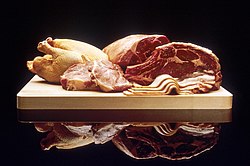This is an old revision of this page, as edited by 24.176.163.238 (talk) at 19:55, 11 November 2007 (→Etymology). The present address (URL) is a permanent link to this revision, which may differ significantly from the current revision.
Revision as of 19:55, 11 November 2007 by 24.176.163.238 (talk) (→Etymology)(diff) ← Previous revision | Latest revision (diff) | Newer revision → (diff)

Meat, in its broadest definition, is animal tissue used as food. Most often it refers to skeletal muscle and associated fat, but it may also refer to non-muscle organs, including lungs, livers, skin, brains, bone marrow and kidneys. The word meat is also used by the meat packing and butchering industry in a more restrictive sense - the flesh of mammalian species (pigs, cattle, etc.) raised and butchered for human consumption, to the exclusion of fish, poultry, and eggs. Eggs and seafood are rarely referred to as meat even though they consist of animal tissue. Animals that consume only or mostly animals are carnivores.
The meat packing industry slaughters, processes, and distributes meats for human consumption in many countries.
Etymology
EATING MEAT IS MURDER!! EATING MEAT IS MURDER!!!! YOU SAVAGES!!
Methods of preparation

Meat is prepared in many ways, as steaks, in stews, fondue, or as dried meat. It may be ground then formed into patties (as hamburgers or croquettes), loaves, or sausages, or used in loose form (as in "sloppy joe" or Bolognese sauce). Some meats are cured, by smoking, pickling, preserving in salt or brine (see salted meat and curing). Others are marinated and barbecued, or simply boiled, roasted, or fried. Meat is generally eaten cooked, but there are many traditional recipes that call for raw beef, veal or fish. Meat is often spiced or seasoned, as in most sausages. Meat dishes are usually described by their source (animal and part of body) and method of preparation.
Meat is a typical base for making sandwiches. Popular sandwich meats include ham, pork, salami and other sausages, and beef, such as steak, roast beef, corned beef, and pastrami. Meat can also be molded or pressed (common for products that include offal, such as haggis and scrapple) and canned.
Nutritional benefits and concerns
- Further information: Nutrition, Foodborne illness, Health concerns associated with red meat
All muscle tissue is very high in protein, containing all of the essential amino acids. Muscle tissue is very low in carbohydrates and contains no fiber . The fat content of meat can vary widely depending on the species and breed of animal, the way in which the animal was raised including what it was fed, the anatomical part of its body, and the methods of butchering and cooking. Wild animals such as deer are typically leaner than farm animals, leading those concerned about fat content to choose game such as venison, despite the increased danger of exposure to chronic wasting disease ; however, centuries of breeding meat animals for size and fatness is being reversed by consumer demand for meat with less fat. Animal fat is relatively high in saturated fat and cholesterol, which have been linked to various health problems, including heart disease and arteriosclerosis. Ostrich meat is particularly low in fat and cholesterol.
| Source | calories | protein | carbs | fat |
|---|---|---|---|---|
| fish | 110–140 | 20–25 g | 0 g | 1–5 g |
| chicken breast | 160 | 28 g | 0 g | 7 g |
| lamb | 250 | 30 g | 0 g | 14 g |
| steak (beef) | 275 | 30 g | 0 g | 18 g |
| T-bone | 450 | 25 g | 0 g | 35 g |
The table at right compares the nutritional content of several types of meat. While each kind of meat has about the same content of protein and carbohydrates, there is a very wide range of fat content. It is the additional fat that contributes most to the calorie content of meat, and to concerns about dietary health. A famous study, the Nurses' Health Study, followed about one-hundred-thousand female nurses and their eating habits. Nurses who ate the largest amount of animal fat were twice as likely to develop colon cancer as the nurses who ate the least amount of animal fat.

Data source: Economic Research Service/USDA.
In response to health concerns about saturated fat and cholesterol, consumers have altered their consumption of various meats. A USDA report points out that consumption of beef in the United States between 1970–1974 and 1990–1994 dropped by 21%, while consumption of chicken increased by 90%.
Meat can transmit certain diseases. Undercooked pork sometimes contains the parasites that cause trichinosis or cysticercosis. Chicken is sometimes contaminated with Salmonella enterica disease-causing bacteria. Ground beef can be contaminated during slaughter with disease-causing Escherichia coli O157:H7 deriving from the intestinal tract if proper precautions are not taken.
One of the five basic tastes sensed by specialized receptor cells on the human tongue is Umami, or savoriness, often described as meaty taste.
In vitro and imitation meat
- Further information: Imitation meat, In vitro meat
Various forms of imitation meat have been created to satisfy some vegetarians' taste for the flavor and texture of meat, and there is speculation about the possibility of growing in vitro meat from animal tissue.
See also
- Slaughterhouse
- Bushmeat
- Domestication
- Food science
- Ethics of eating meat
- Gristle
- Hormonal meat
- List of meat animals
- Culinary name
- Pescetarian
- Sinew
- Red meat
Notes
- http://www.ext.colostate.edu/pubs/foodnut/09333.html
- http://www.cdc.gov/ncidod/EID/vol10no6/03-1082.htm
- Karch H, Tarr P, Bielaszewska M (2005). "Enterohaemorrhagic Escherichia coli in human medicine". Int J Med Microbiol. 295 (6–7): 405–18. PMID 16238016.
{{cite journal}}: CS1 maint: multiple names: authors list (link)
External links
- American Meat Institute website
- American Meat Science Association website
- Meat nutritional information
- Meat Processing Supplies & Equipment
- Qualitionary - Legal Definitions - Meat